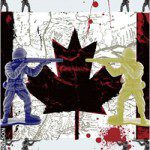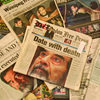Tech War
In Iraq, on the strangest "stakeout" of my career: a report from the front lines of technology and journalism
A red-hot email alerted me: my CBS television news team had to mobilize fast. We left Baghdad in a convoy of SUVs, with the all-important satellite truck, SAT phones, and laptops heading for Tikrit, where Saddam Hussein had been captured. Only a few hours later, our genius satellite truck operator got us on the air – and kept us on the air even in the midst of a wind and rain storm.
It was a massive team effort. Camera and sound operators laid cable and chose the best locations for standups and interviews, while also preparing for the military’s live press conference. Getting it back home meant satellite and Internet contact with the editorial and production desks back in New York.
Meanwhile, I chased sources and set myself up inside the front door of Saddam’s Tikrit palace with my laptop on a crate, trying to pull pieces together into a script. A soft, somewhat gaudily decorated armchair from the main dining room completed my desk, while the computer and phone line stretched dozens of feet to the technical hub – the truck.
We maintained constant contact with the bureau in Baghdad and the main desk in the United States – a steady stream of crucial information across thousands of kilometres, with dozens of people coordinating feeds from several different locations to create a comprehensive whole. It was the crowning moment of an assignment that had started a year earlier.
Covering a war is a challenge for any correspondent, but today some television journalists wear their broadcast tools the way they wear flak jackets. In early winter 2003, a number of my colleagues and I began preparing to cover the expected U.S. invasion of Iraq. Besides being trained to keep our heads down, we learned how to compress field material and send it back to headquarters over the Internet.
The gear: a small handheld video camera common to any consumer with a few thousand dollars to spare. The goal: get the interviews, gather up the video, put together what is most newsworthy and relevant, and then send it by email using a portable satellite dish. That bears repeating: it was sent by email. So I travelled with a laptop in a waist pack, while my cameraman hauled the technical gear in a knapsack. Just like the American soldiers, we had backpacks and duffle bags for the rest – including clothing, toiletries, and a spare chemical suit. But any trip to the front meant moving with only what we needed: helmets, bulletproof vests, chemical masks, a compact TV, and transmission gear.
Ready for action, I found myself assigned to the 4th Infantry Division for several weeks. Unfortunately, we ended up stalled in Kuwait only a few kilometres from the Iraq border. Turkey had denied the U.S. a base for an attack from the north, so the unit was forced to reposition far south – a task that took so long that most of the 4th Infantry Division missed the major battles. We weren’t in the middle of the action, but we gathered what we could for broadcast.
Still, I won’t easily forget the strangest “stakeout” of my career. My camera operator and I found two chairs – this was a base camp, after all – and planted them outside the 4th Infantry Division’s command centre, set up the camera using the position of the sun to create the proper lighting, and waited in the desert. I paced most of the time – my gas mask constantly thumping against my left leg – ready to pounce on the commanding general as soon as he emerged. When he finally did, he answered my questions. My camera operator and I then scrambled quickly to our tent, where we edited the material on his computer. He established a satellite link and transmitted the general’s video comments by email. It took a couple of hours, but the clips made it there in time to be included in another correspondent’s piece.
Today, TV journalists can gather and send information using reasonably lightweight equipment. But while we may be agile and fast, we still have to get the story. No matter how good the technology, we must still live with the editorial bottom line: everything in context.
Coincidentally, our news-gathering process was parallel in many ways to the military’s maneuvers. The tank battalion of the all-male 4th Infantry Division was the U.S. Army’s most sophisticated, digitized and highly mechanized unit. Onboard computers linked one tank to the other as well as to the regional commander and central command. Again, we sent the information by email. Individual tank crews could pinpoint allied and enemy positions, helping make the battle decisions, which went up the e-line. This information contributed to the comprehensive outline of the war map – which also included air and sea components – at central command in Qatar.
It was ironic that one of the war’s biggest stories, the capture of Saddam, was reported live from the despot’s former palace. The 4th Infantry Division – “my guys,” the ones who spearheaded it – set up operations, including a full communications system, in his Tikrit palace. They then used it as a launching site for almost daily raids in their search for him. To report on the capture, low-flying Black Hawk helicopters transported a group of journalists, including me, to Saddam’s hiding place, and flew us back out in time to get our video and interviews on air.
With all the new technological tricks of the trade, there’s a danger that we too often take the story for granted. We shouldn’t. We must remember that the journalist’s job hasn’t changed: it’s to get the story and do it well. That’s the challenge and that’s as exciting as ever.










































